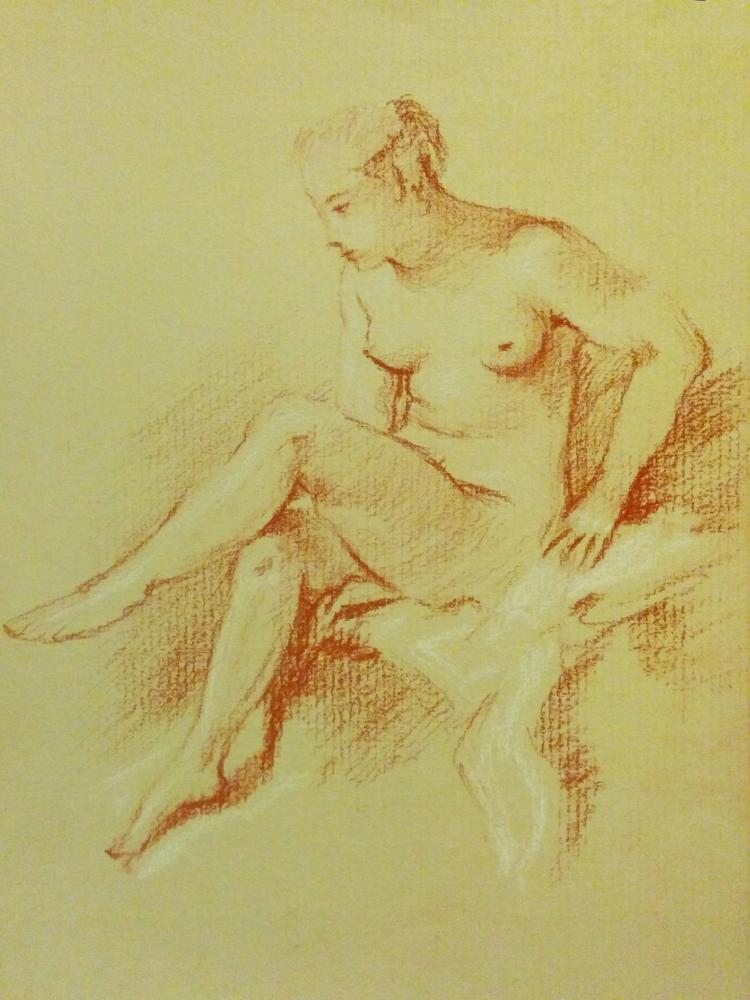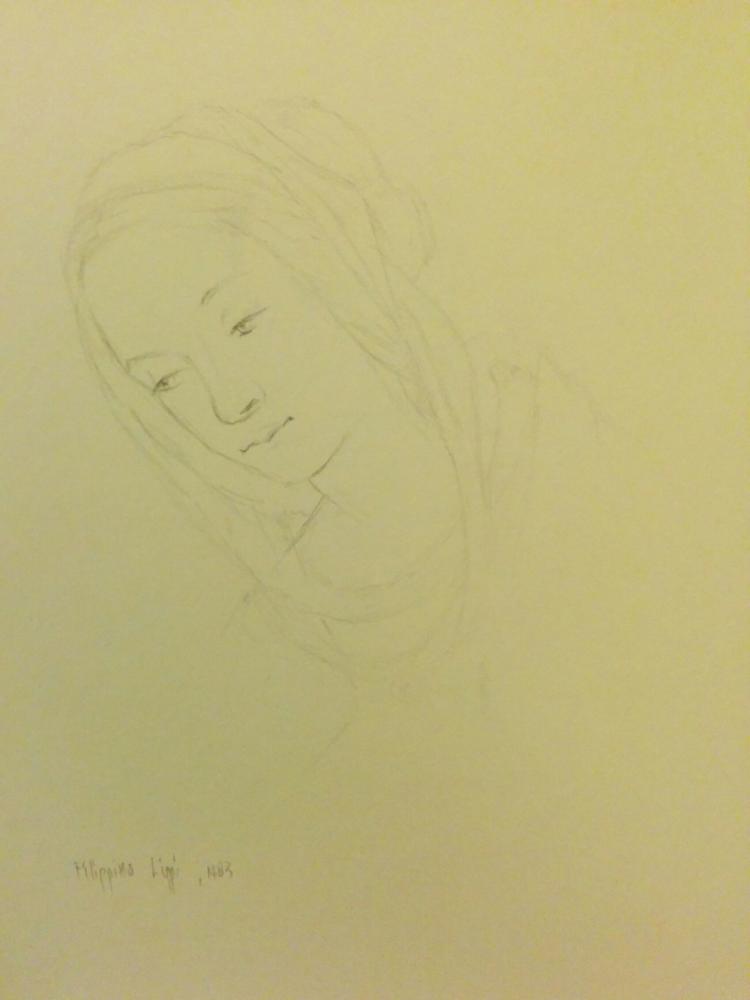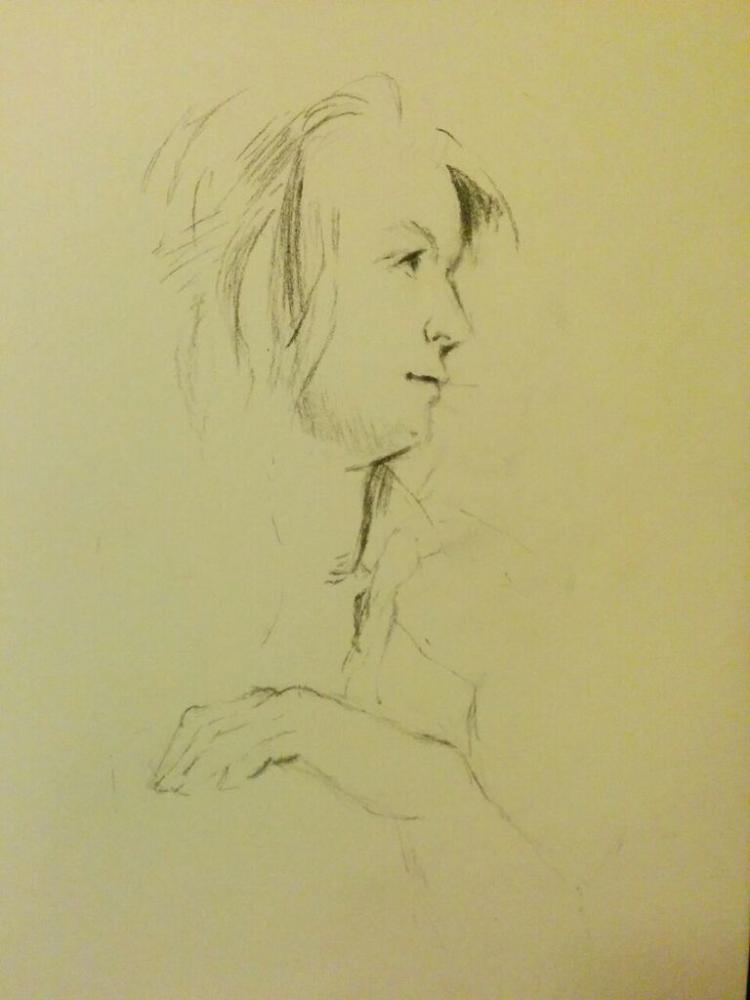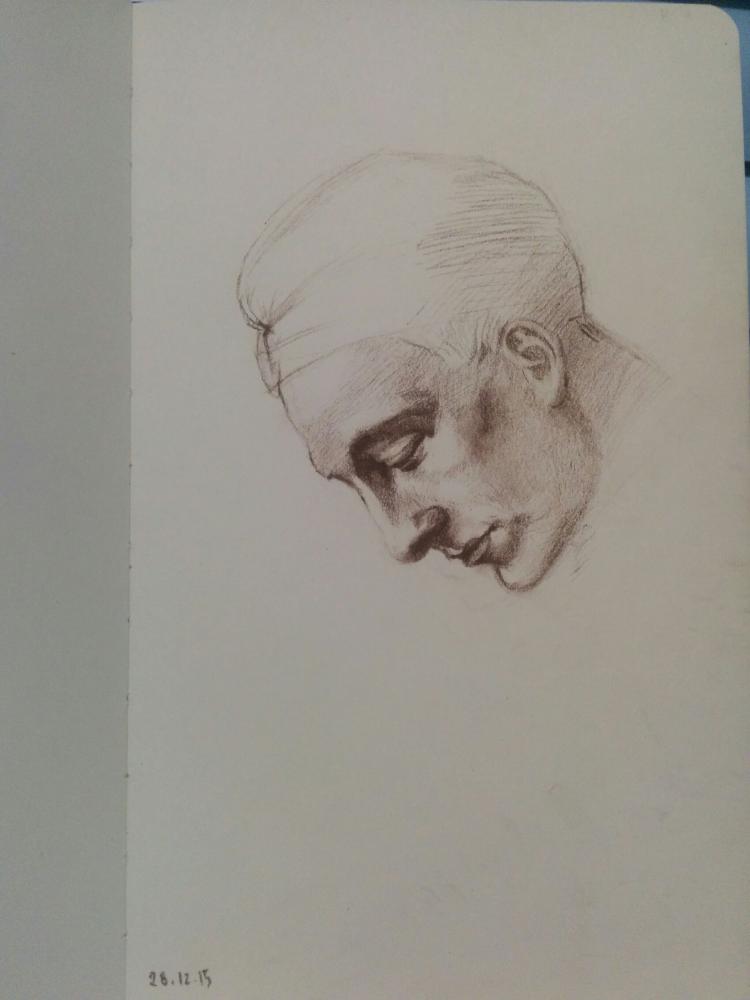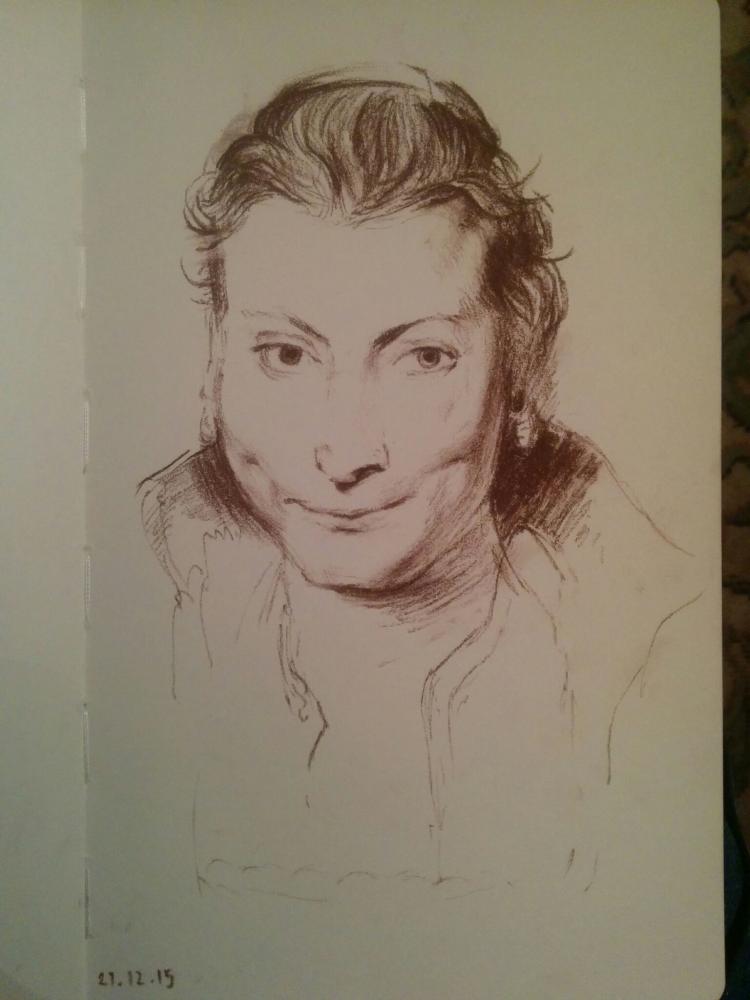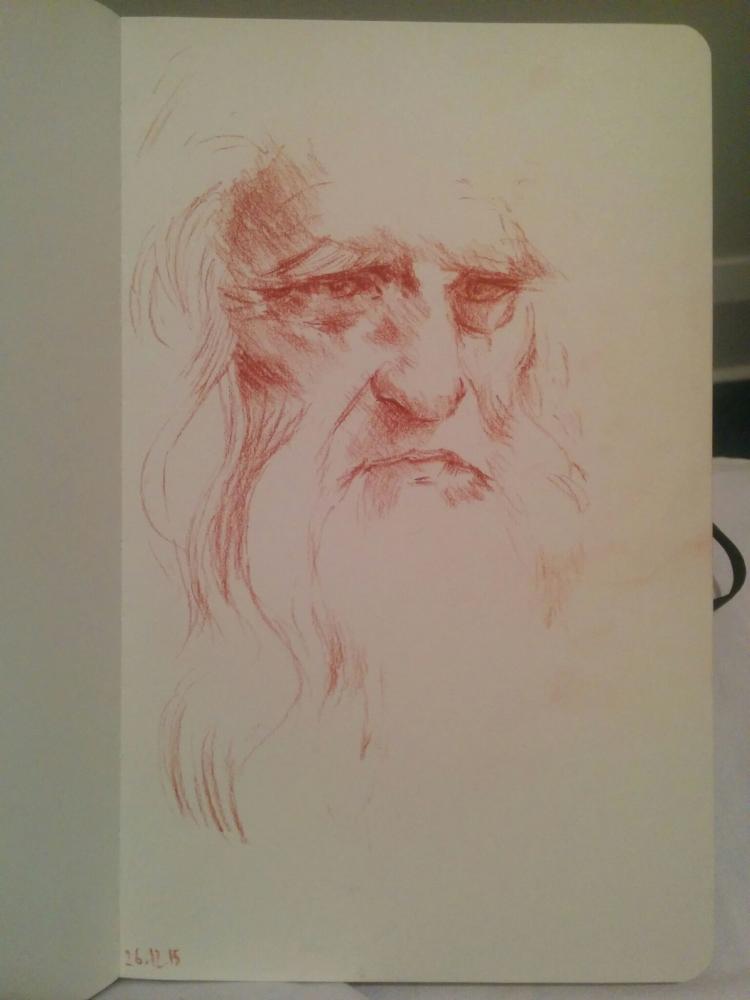I went to the prints and drawings room at the Met today and was captivated by a chalk nude by François Boucher. I had my toned paper and conté pencils with me so I was able to take the time to do a proper study of it. Although I have made some errors and although I wasn't able to sharpen my pencils to get the line quality I needed I am pleased with the result.
I feel like I have discovered a new artist whom I never thought I would have liked. His paintings are undeniably saccharine but are so technically virtuoso that I can't help but like them. His Toilette of Venus, also at the Met, is so sumptuously rich that I feel like I should hate myself for indulging in it, but I love it nonetheless.
The more art I look at the more I think that half the battle is in just getting started and ploughing on through the bad times. I often feel an overwhelming anxiety about starting anything because I want it to turn out perfectly every time, and because I know it won't I don't even bother. The fact is that even the masters had bad days and almost all of them have weak passages in their paintings, but they pressed on regardless and just kept producing new work. I think being prolific is key: just keep pumping stuff out, learning from mistakes and not giving up. This is true of most things I think.
It feels great to be in this extraordinary city for the start of a new year, and I'm so pleased to have committed to this project. I just hope I don't make my self sick of art.
Today I spent the afternoon at the Met. I confined myself to the European paintings section, and skipped a good deal, and yet I still feel quite overwhelmed. It is a truly staggering collection, in size, diversity and quality. I'm not sure the 30 remaining days I have here are enough to do it justice.
Amongst so many things, my attention was arrested by some landscapes by Claude (primed no doubt by my walk through North Woods in Central Park), Velazquez (because of Goya yesterday in London), Bronzino for his beautiful creamy, sculptural skin tones and finally Filippino Lippi for his breathtakingly beautiful Madonna, who almost out-Boticcellis Botticelli. I stood and sketched today's drawing from it, working slowly and lightly in 2B pencil.
A significant motivation for choosing the Lippi to copy was a practical one -- it is located in a less busy room, so the distraction of passers-by is less than the rooms with more famous paintings. This got me thinking about the practical concerns of art - the logistical, the human, the contingencies of chance and convenience. Standing still, being tired, aching, being hungry in front of a work today made me remember that these inert, lifeless, silent objects were quite literally painstakingly created by real, living people who suffered to produce them. Feeling physical discomfort myself whilst sketching made me really think about how much physical, tiring, sweaty labour went into these works. I have a tendency to see art as pre-existing, rarefied entities quite unconnected from the human everyday world. And then I sneeze on my work and realise that the great masters probably did the same, and that probably bits of their hair got stuck in their paint as well, and their cuffs brushed against the still-wet surfaces of their canvases, ruining their clothes like I do.
Today's drawing is fairly execrable, but I am going to excuse myself as I was on a transatlantic flight. I'll do a better version tomorrow -- the original drawing is an exquisite study by Rubens. Check out the free pdf of Peter Paul Rubens: The Drawings (2005) from the Met, from which I will be working extensively I think. Note that there are hundreds of high-quality free PDFs on that site that are worth looking at.
I managed to squeeze in an hour at the Goya exhibition before my flight. Much too much to take in, but I now know what I need to go back and look at in more detail. He's great at describing textures with an almost abstract abandon in some later work, and he makes excellent use of the palette knife when he's rendering lace. Need to look into Velázquez as well.
Tomorrow I fly to New York for a month. It is the start of my modern take on the grand tour of the world's greatest art collections as part of my goal to travel for art. I'm intending on spending most of my time in the Met.
I'm also hoping to drop in on the Goya exhibition at the National Gallery on my way through London.
A couple of years ago I never looked to other artists for inspiration, and wouldn't have voluntarily gone to a museum or gallery. When I worked in London I started making a concerted effort to go to the galleries, and over time came to realise how much I could learn from looking at great work and asking how the artist solved particular problems.
The more I try to uncover the secrets of how artists achieved their effects the more I have become interested in art history, particularly the biographies of individual artists. Part of the motive of reading how a work was made, how an artist lived and how a technique was perfected is to plunder tips for my own benefit, part is for the sheer pleasure of learning something new, but a significant part is to experience the pleasure of recalling that learning when confronted by the painting or the artist again. Showing that learning off, whether out-loud to others or just reflecting it back to myself in my head with the knowing smile of the initiate sometimes exceeds the pleasure of enjoying a work purely on its artistic or aesthetic merits. I think that is one of the principle joys of art for connoisseurs, who can use the piece largely as a means of drawing attention to their own learning and taste, and secondarily enjoy it in and of itself.
I like the idea of approaching a work with ignorance, reacting emotionally to it and then intensifying the love for it through learning everything there is to know about it.
Reflections on today's drawing
This is taken from a copy of Michelangelo's Study of an Inclined Head, which he did in red chalk. I spent about two hours on this, and tried to work lightly at first as conte pencils are hard to erase. I have got the overall proportions better today, though the eye is too big -- a common mistake I make, even though I'm aware of it. I have also over-worked the shading on the cheek and the chin, which makes her look bruised and like a wax model. She's also now androgynous in my version, and she has lost all of the grace and subtlety of the original.
I think the drawings are fine in their own right but look extremely poor when compared side-by-side with the originals. I will try to spend more time on the next copies to get closer to the mood of the originals. I will strive for a vital fluidity.
Day two and I realise I haven't specified what my daily writing should be about or who it should be for. I think I shall write it for myself. Maybe it should be like Meditations.
I have been thinking about the quantified self. I have been using a pedometer on my phone for the last couple of days because I was interested to see what 10,000 steps a day felt like. At the same time I am at my Grandma's and I am confronted by a person who will never walk another step again on her own.
It has made me think about the fact that we can be described by a series of finite numbers. There are a definite number of steps that you will walk in your lifetime, a finite number of times your heart will beat. You can take an average of the population and plot your lifetime's progress against it. It is as obvious and as incomprehensible as the realisation that there will be days when you are no longer alive and yet everything will continue to exist as before.
It reminds me of a quotation from Proust's Within a budding grove, when the narrator realises that he is already part-way through his life and that every day may not in fact be the start of something new.
"...when he spoke of my inclinations as no longer liable to change, he awakened in me two terrible suspicions. The first was that (at a time when, every day, I regarded myself as standing upon the threshold of a life which was still intact and would not enter upon its course until the following morning) my existence was already begun, and that, furthermore, what was yet to follow would not differ to any extent from what had already elapsed. The second suspicion, which was nothing more, really, than a variant of the first, was that I was not situated somewhere outside the realm of Time, but was subject to its laws..."
À l'ombre des jeunes filles en fleurs / Within a budding grove - Marcel Proust
Reflections on today's drawing
Today I attempted to make a copy of Rubens' drawing of his first wife Isabella Brant. I used a conte crayon that I couldn't get sharp enough.
I can hardly bear to look at it now, it's so far from the original. I didn't capture the likeness because I didn't take time to measure the proportions properly. Tomorrow my single goal will be to get correct proportions. It's a recurrent problem and I never have the discipline to overcome it because I'm lazy and hate measuring.
It is much easier to carry around the idea of yourself as the next great artist in your head without actually producing any work to contradict your false impression of yourself. When I produce work so full of error and so manifestly inferior to the original I am faced directly with my own shortcomings. I've been demotivated and depressed about it. The worst part is that I was so pleased with it whilst I was doing it, and only later do I see how amateur an attempt it is. The only thing to do is to use it as a motivation to improve, but it saps my energy to see how far my abilities are from the absurd, counter-factual opinion I hold of myself.
I have been worrying about whether or not to embark on this project for a couple of weeks now. I lay in bed for an hour this morning thinking about how dreadfully long 1000 days is, and what a burden this project would be if I commit to it. I thought of all of the reasons why I shouldn't bother and why this is actually a waste of my time.
I know that there are many difficulties in achieving something every day for 1000 days. I know that I will be lazy or ill or tired or grieving and that I will have better things to be doing. I know that my priorities will change and that my goals will change and that I will want to stop. I also know that the structure of the project itself -- repeating something every day -- is inflexible and is arguably of questionable utility. But it is a structure that I have tried before and has yielded results that I am proud of. I think it can help me be the person I want to be.
Recently I feel like I have been drifting and don't have a clear aim, and so I have been thinking hard about what I want in my future and how that should influence how I act in my present. I want to be able to say to myself that I took advantage of the opportunities available to me and that I stayed true to who I am. This project is a framework for interrogating who I am, what I want, and what I should be doing. The goals I have chosen to work towards -- to read, to write, to draw, to travel -- will, at the least, allow me to live without the regrets that I never followed my passions. The regret of not settling down to a proper job and following a steady career is another matter, and one I am wrestling with.
I am aware of the value of being young, healthy, and without many responsibilities. I want purposefully to take advantage of these privileges to maximize the opportunities I have to create new things, think new thoughts and see new places. I think often about the idea of self-authoring your personality, writing your own character and living a self-authored life.
